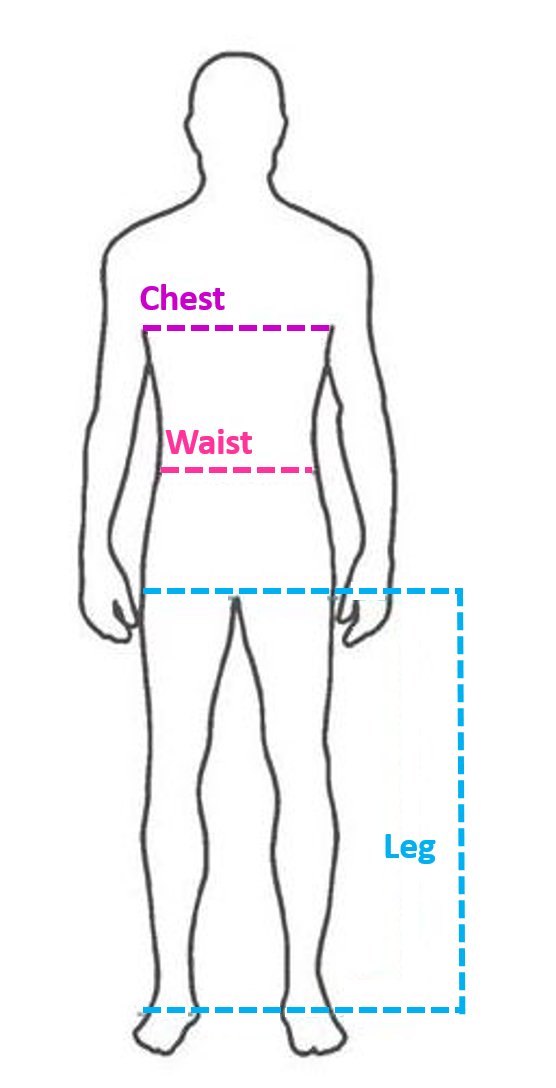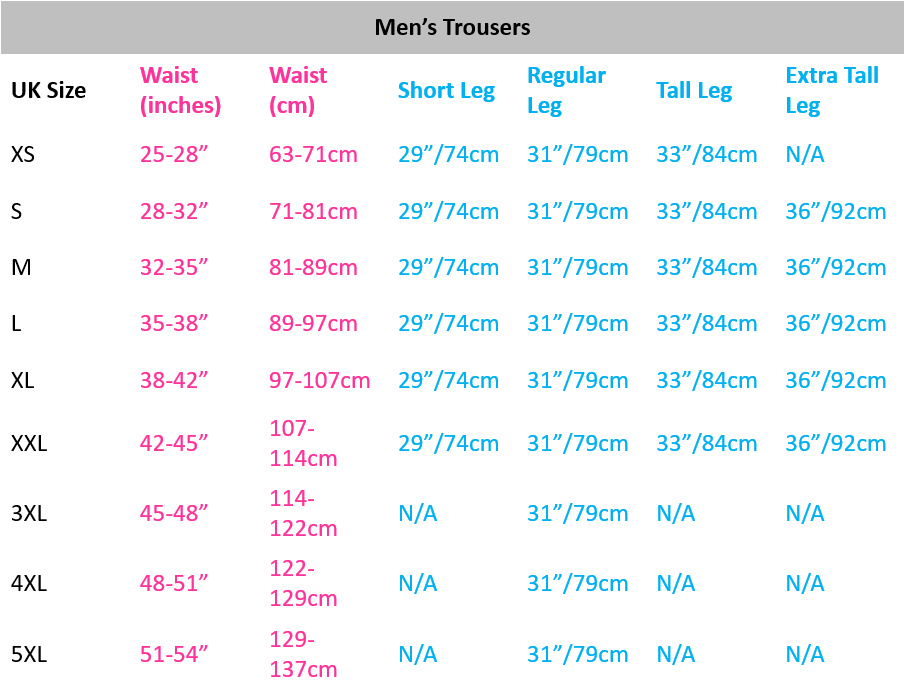CLOTHING SIZE


TROUSER SIZES



FOOTWEAR SIZES


GLOVE SIZES

TO FIND OUT YOUR GLOVE SIZE:
1) Measure around your hand with a tape measure across your palm.
2) Measure length from base of hand to tip of middle finger

EN STANDARDS
It is essential that anyone using a chainsaw either on or off the ground is provided with and wears appropriate PPE. Non-chainsaw users may also need to wear appropriate PPE, for example head, hearing or eye protection as identified in the task risk assessment.
It should be noted that no personal protective equipment can guarantee complete protection against cuts from handheld chainsaws. There is no substitute for the correct training and safe work methods. Below is a brief outline of the standards cited on this website.
EN ISO 17249: Safety footwear and resistance to chainsaw cutting.
EN ISO 17249 is a harmonised standard and includes many different tests.
As a minimum, to achieve this standard footwear must:
A) Comply with all the requirements of safety standard footwear (EN ISO 20345 B)
B) Be tested for chainsaw resistance by standard EN381-3
EN 381: PROTECTION AGAINST HAND-HELD CHAINSAWS
The European standard EN 381 complies with protective clothing for chainsaw users.
This norm is divided into different parts (or designs). Each part treats a specific part of the body:
EN 381-3 - Test methods for footwear. Footwear should be certified to the harmonised standard
EN ISO 17249 EN 381-5 - Requirements for leg protectors (the norm allows for 2 types or forms - Type A and Type C with different areas of protection)
TYPE A
TYPE C
EN 381-7 - Requirements for chainsaw protective gloves
EN 381-9 - Requirements for chainsaw protective gaiters
EN 381-11- Requirements for upper part of the body
The norm also prescribes 4 classes that correspond to the chain speed with which the tests have been done:
Class 0 : 16 m/s
Class 1 : 20 m/s
Class 2 : 24 m/s
Class 3 : 28 m/s
BS EN 471: HI-VISIBILITY CLOTHING
Hi Vis garment types are grouped into three classes based upon the conspicuity provided, with the classes dictating the minimum quantities of background and retro-reflectieve materials used.
CLASS 3 - Highest Protection Level of Hi-Vis Clothing Band of retro-reflective material shall not be less than 50mm wide. Minimum background material 0.80m sq. Minimum retro-reflective material 0.20m sq.
CLASS 2 - Intermediate Protection Level of HiVis Clothing Band of retro-reflective material shall not be less than 50mm wide. Minimum background material 0.50m sq. Minimum retro-reflective material 0.13m sq.
CLASS 1 - Lowest Protection Level of HiVis Clothing Band of retro-reflective material shall not be less than 50mm wide. Minimum background material 0.14m sq. Minimum retro-reflective material 0.10m sq.
NB: BS EN 471 standard items must have a Yellow or Orange background. HiVis items of other colours will NOT conform to UK and EU standards for High Visibility clothing
RIS-TOM 3279 HI-VISIBILITY CLOTHING FOR RAIL (Formerly GO/RT 3279)
The GO/RT 3279 standard is based on the European standard EN ISO 20471:2013. It requires garments to meet at least class 2 (the mid-point of a 3-class scale) of EN ISO 20471 for the minimum area of high visibility materials used within a garment. Whereas the European standard permits several different colours of high visibility materials, the railway standard specifies an orange colour.
These fluorescent garments for night-time visibility feature retroreflective tapes.
Railway locomotive headlights pick out retro-reflective materials in high visibility clothing. Again, the railway standard draws on EN ISO 20471:2013 and specifies materials for use that meet the highest level of photometric performance criteria that are specified within the standard.
EN343: PROTECTION CLOTHING PROTECTION AGAINST RAIN
The EN343 is a European safety standard set to specify a minimum level of protection required from your workwear and PPE against foul weather. This standard takes into consideration the entire garment, as well as its fabrication to judge the level of protection it provides the wearer.
The certification is split into two categories the first, X judges precipitation, fog and ground humidity. The second, Y measures the garments breathability in those conditions. Consequently, these categories are then rated from 1-3, with 3 representing the highest level of protection or breathability.
Therefore, a garment classified as EN343 3:3 means both the waterproofing and breathability are excellent providing the wearer with the highest level of protection from wind and rain.
EN388: PROTECTIVE GLOVES AGAINST MECHANICAL RISKS
EN388: PROTECTIVE GLOVES AGAINST MECHANICAL RISKS
The EN 388 standard is used to test work gloves for a variety of properties. In brief, these properties are: cut resistance; tear resistance; abrasion resistance; puncture resistance and impact resistance. Gloves complying with EN388:2016 will display a pictogram as shown, with 5 or 6 characters relating to the properties shown below:
1st Character: Abrasion resistance (Numeral 1 to 4 with 4 being the best resistance)
2nd Character: Blade cut resistance (Numeral 1 to 4 with 4 being the best resistance)
3rd Character: Tear resistance (Numeral 1 to 4 with 4 being the best resistance)
4th Character: Puncture resistance (Numeral 1 to 4 with 4 being the best resistance)
5th Character: Further blade cut resistance test if excessive blunting of blade occurs during 1st test (Letters A to F with F being the best resistance). An X is displayed if this test is not needed.
6th Character (Optional): Impact resistance. (“P” if requirements are met)
KWF PROFI MARK
The “KWF Profi” mark is issued by The Kuratorium für Waldarbeit und Forsttechnik, a German research organisation.
“KWF PROfi” is a quality assurance mark which is attained after the products have gone through many months of testing with foresters in and around Europe.